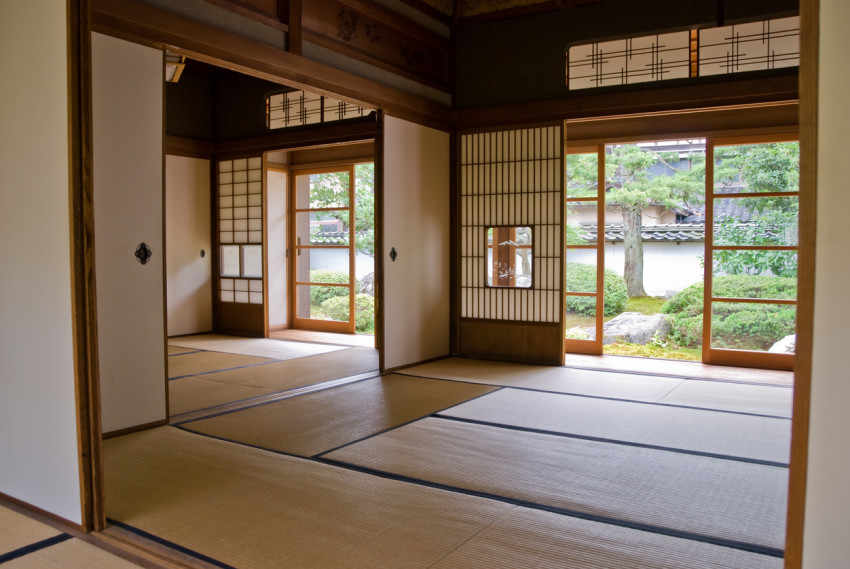The tatami room, better known as 和室 (washitsu, “Japanese-style room”), is a space that features tatami mats as its main flooring element. Tatami mats are made from woven straw with a rice straw core and have been a staple in Japanese homes for centuries. They are typically about 90 cm by 180 cm in size, although the dimensions can vary by region (sizes listed below).
Japanese-style spaces and tatami are closely attached, as thick as thieves. Even today, tatami mats are widely used in houses, ryokan (traditional inns), onsen (hot spring baths), and even restaurants and cafes. The tatami room is also still present in many housing buildings in Japan, regardless of how modernly chic the houses are. While the room strongly boosts the space’s Japanese heritage essence, its great functionality and usage adaptability ensure its relevance in current dwellings.
Tatami History
The Japanese word tatami traces its origin back to the verb 畳む (tatamu; to fold). This comes from the simple fact that when not in use, the mats were often folded or stacked. Originally woven from rice straw, tatami were thin mats that people sat or slept on for comfort. They were designed to offer a cushion against the hard wooden or dirt floors of early Japanese homes.
During the Muromachi Period (1336–1573), the tatami room was mainly used by the elite as a study or meditation room. Over time, it gradually became more common among the general population, expanding into living and sleeping areas. By the Edo Period (1603–1868), washitsu had become a quintessential part of Japanese home design.
Tatami mats have evolved in modern times. While traditional mats were relatively thin at first, modern tatami is much thicker. It resembles more of a panel rather than the lightweight mats of the past. They are still made from straw at their core, but many are now layered with denser materials, such as compressed wood or foam, to provide more durability and insulation.
Washitsu Breakdown
The contemporary era has seen the washitsu retain its rich heritage value. Many Japanese occupants use it today as a multi-purpose room that can quickly and easily be repurposed to suit, well, just about anything. From a specifically purposed space — such as a bedroom or living room — to a more flexible area, namely a family room or activity room, there is an endless possibility for the space.
Tatami & Space
Click here to read more.
- External Link
- https://savvytokyo.com/
 Get your ticket to GaijinPot Expo 2024
Get your ticket to GaijinPot Expo 2024















3 Comments
Login to comment
sakurasuki
Tatami seems nice until you need move out, just wait for the bill.
https://en.roocas-one.co.jp/blog/moving-out-in-japan-apartment-restoration/
browny1
The soft to foot touch, the pleasing to the eye muted tones and the flexibility in renewing/moving are all positive aspects of tatami. Aesthetically they are a winner.
On the down side they can harbor mites and other bugs, they slowly breakdown releasing dust particles that may not be perceptible but not good for health and full replacement can be expensive.
My house had 5 tatami rooms. One changed to flooring a while back and 3 more will be changed to flooring in the next year. This will leave one 6 mat room as a guest room.
Why change? For all of the reasons listed above.
Flooring maintenance is minimal and throw-ever mats/rugs can be easily cleaned.
But there's no beating the smell/look/feel of new tatami. I guess if I had tons of money I'd keep the tatami and just replace them very often - like some folks do.
But alas.
kohakuebisu
The story is ostensibly correct about the history of tatami but exaggerates their role in modern houses. Tatami are not the "heart" of "contemporary" homes built in the last 30 years. Many have zero tatami and that the ones that do will have one room at most, which is for occasional use and is off to the side, not the "heart" of the house. The heart of the modern house is the LDK.
Maybe someone out there has done it, but I've never heard of anyone buy an old house and renovate it to add tatami. The opposite, renovating to get rid of tatami, is extremely common. Placing heavy furniture such as beds on tatami, traditionally a definite no-no, is also quite common now. Nobody cares whether it will dent the tatami.